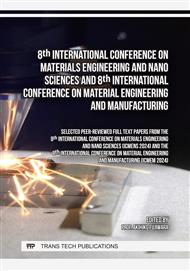p.53
p.59
p.65
p.71
p.79
p.87
p.93
p.99
p.105
Optimization of Helical Gear Plunge Shaving Cutting Parameters for Cutter Life Using Taguchi Method
Abstract:
Gear shaving is a vital part of gear tooth finishing during the pre-hardened condition. Taguchi method was used to design a technique on selecting optimum gear cutting parameters, and on setting a standard in process programming of MHI FEN30A 4-axis shaving machine, for shaving of SCM20H material helical gear using plunge pattern. The final cutting stock, final feed rate and spindle speed were selected as the shaving parameters. Many experiments were conducted using the L16 orthogonal array. S/N response table shows the optimum cutting parameter combinations for cutting load, cutting time, and crowning which are A4B1C1, A1B1C4, and A3B4C4 respectively. The final feed rate is the most significant cutting parameter for the optimization of cutting load, cutting time, and crowning, having ANOVA percentage contributions of 49.6%, 99.01%, and 92.45% respectively. Quadratic regression was used to model predictive equations and contour plots having R2 values of 91.75%, 99.79%, and 91.81%. Predicted values from the quadratic regression model and estimated Taguchi optimum response were compared to the actual results using the optimum parameters for the validation of the experiment. All experimental results are within the 95% confidence of interval, and the percentage error between the experimental and predicted values are all below the acceptable 20%. Regression contour plots can be used for the selection of cutting parameters in process programming, given that the final feed rate is the priority for considering the cutter life, and secondly is the final depth of cut.
Info:
Periodical:
Pages:
99-104
Citation:
Online since:
September 2024
Keywords:
Price:
Сopyright:
© 2024 Trans Tech Publications Ltd. All Rights Reserved
Share:
Citation:



